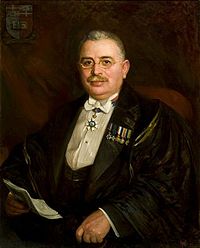Themistocles ('Temi') Zammit
Themistocles ('Temi') Zammit
Contents
Notes
Office Notes
House Notes
death noted in Report of the Council 1935-1936
obituary in Man 35, 61
Notes From Elsewhere
Sir Themistocles "Temi" Zammit (or Żammit; September 30, 1864 – November 2, 1935) was a Maltese archaeologist and historian, professor of chemistry, medical doctor, researcher and writer, serving as Rector (1920–26) of the Royal University of Malta and first Director of the National Museum of Archaeology in Valletta.[1]
After graduating in medicine from the University of Malta, Zammit specialised in bacteriology in London and Paris. His 1905 discovery of contaminated milk as the vector for transmission to humans of Brucellosis melitensis present in the blood of the goat greatly contributed to the elimination from the islands of undulant fever, earning him the knighthood.[2]
Author of several literary works in the Maltese language, Temi Zammit was conferred the DLitt Honoris Causa by Oxford University. He was knighted in 1930, having previously been admitted as a Companion to the Order of St Michael and St George. He also published a history of the Maltese islands and excavated important archaeological sites, such as the Hypogeum and the megalithic Tarxien Temples, Ħaġar Qim and Mnajdra, which have since been declared UNESCO World Heritage Sites.
Zammit's scientific approach to archaeology further enhanced his international reputation. A permanent display of some of his findings may be viewed at the National Museum of Archaeology in Valletta.
The main Assembly Hall of the University of Malta was named after him. He also appears on a commemorative 1973 Maltese pound coin.
Zammit has signed most of his works with his initials T. Z.[3]
